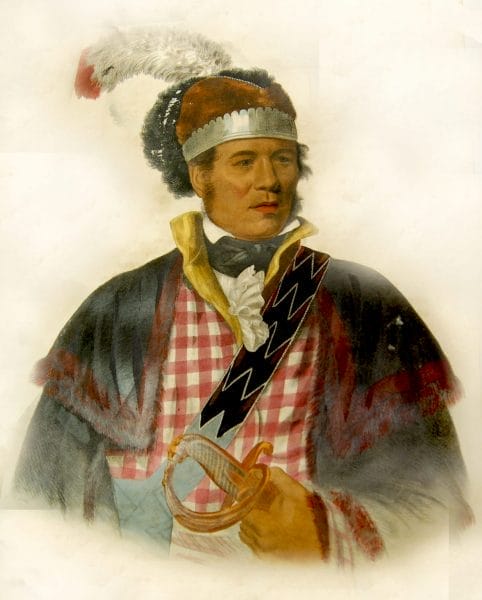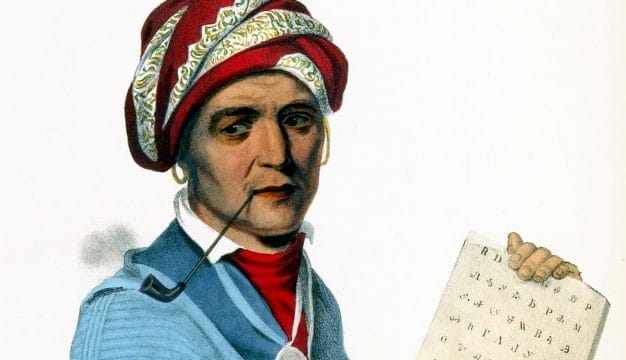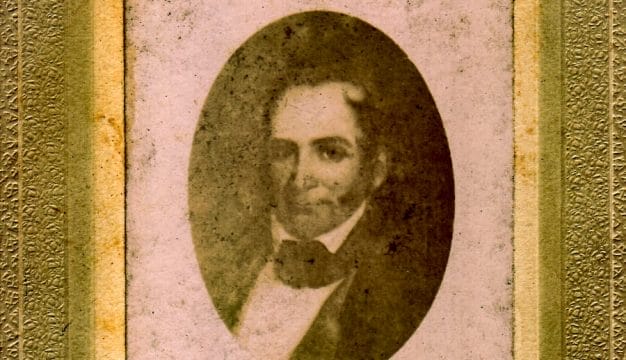William McIntosh
William McIntosh (ca. 1775-1825) was a controversial nineteenth-century Creek Indian leader. A planter who owned enslaved Africans, McIntosh opposed the Red Stick majority when civil war divided the Creeks during the War of 1812. He led Creek warriors in raids on Florida Indian settlements during the First Seminole War. He was a masterful political manipulator who tried to centralize power among the Creeks, repeatedly arranged and accepted bribes from American officials, and signed treaties that ceded most of the Creek’s southeastern lands to the United States government in return for personal gain. He was executed by agents of the Creek National Council for his actions in 1825.
 William McIntosh
William McIntosh (also known as Tustunnuggee Hutkee) was born in the mid-1770s in the Lower Creek town of Coweta, in what is now Carroll County, Georgia. Like many Creeks, McIntosh was of mixed parentage. His father, Capt. William McIntosh, moved to Creek territory during the American Revolution, when his loyalty to the British Crown aroused the anger of many of his neighbors in Savannah, Georgia. McIntosh’s mother, Senoya, was a member of the prominent Creek Wind Clan.
William McIntosh
William McIntosh (also known as Tustunnuggee Hutkee) was born in the mid-1770s in the Lower Creek town of Coweta, in what is now Carroll County, Georgia. Like many Creeks, McIntosh was of mixed parentage. His father, Capt. William McIntosh, moved to Creek territory during the American Revolution, when his loyalty to the British Crown aroused the anger of many of his neighbors in Savannah, Georgia. McIntosh’s mother, Senoya, was a member of the prominent Creek Wind Clan.
Creek Indian society was matrilineal, meaning that ancestry, clan identities, and familial obligations were inherited through the mother’s family. Given his mother’s position, McIntosh was raised according to the norms of Creek society and was thus considered a full member of the community. There were a number of whites living among the Creeks, and McIntosh also became fluent in English and comfortable in the company of white southerners. Family history states that Capt. McIntosh left his Creek family when he was prevented by Senoya’s Wind Clan relatives from taking William out of his village for his education.
As a young man, McIntosh used his multicultural upbringing to rise to prominence among the Creeks. He maintained ties to Indian agents, U.S. military officers, and deerskin traders and used these connections to obtain enough resources to create a large exchange network. McIntosh provided gifts and supplies to his supporters, who in return would listen to his public and private counsel. McIntosh’s authority and influence extended throughout much of the nation. He used these connections and alliances to amass a personal fortune. He readily accepted bribes and pursued his self-interests over those of the Creek Nation as a whole. As a result, McIntosh became a prominent slave owner, innkeeper, and politician. He styled himself a southern planter, building a large home he named Acorn Bluff (Lockchau Talofau) on the Chattahoochee River in present-day Carroll County.
McIntosh’s rise to prominence resulted largely from his relationship with Benjamin Hawkins, the U.S. agent to the Creeks and other southeastern Indians. Hawkins, who lived among the Creek from 1796 to 1816, found a strong ally in McIntosh in his efforts to implement the “plan of civilization,” which aimed to encourage Indians to adopt mainstream American culture. Hawkins employed McIntosh to distribute the annuity owed to the Creeks for earlier land cessions and sometimes paid McIntosh to help implement U.S. policies.
McIntosh also used kinship ties to create a social network that permeated the American South. He had three wives, in accordance with the polygamous norms of Creek society. Susannah Coe McIntosh was a Creek woman; Peggy McIntosh was Cherokee, and Eliza Grierson McIntosh was of mixed Creek and white ancestry. He also benefited from the connections he gained through the marriages of his daughters to Samuel Hawkins, a federal interpreter for the Creeks, and U.S. Indian Agent David Mitchell.
Throughout his career, McIntosh repeatedly signed his name to what were essentially illegal treaties, at least on the Creek side, ceding Creek land. The first of these was the 1805 Treaty of Washington, which ceded the Creek lands that lay between the Oconee and Ocmulgee rivers and gave the United States access to a route (which would become known as the Federal Road) that connected Mobile with the Ocmulgee River. McIntosh would later build and profit from an inn and tavern along this road.
During the War of 1812, McIntosh further alienated many Creeks by opposing the Red Stick faction, which had allied itself with Great Britain. Instead, he allied himself with Andrew Jackson and the United States and other so-called “friendly” Creeks. McIntosh used the ultimate victory of his allies over the Red Sticks to secure additional resources for his supporters. He would continue to ally himself with the federal government in the subsequent Creek War of 1813-14, as did Upper Creek leader Big Warrior.
When David Mitchell replaced Hawkins in 1816, McIntosh found yet another means of benefiting from his situation. Mitchell gave the annuity directly to McIntosh, allowing him to distribute the goods to his loyal followers. Mitchell also helped McIntosh and other Creeks get reimbursement for their property losses during the war and salaries for their service during the War of 1812. Mitchell also gave McIntosh control of the deerskin trade by evicting non-Creek traders from the nation in 1817.
McIntosh’s increasing alliance with the federal government became more evident in 1818 during the First Seminole War. McIntosh once again allied himself with General Jackson, agreeing to attack the Florida Seminoles—many of whom still considered themselves Creeks, had Creek kinsmen, or were descendants of Creeks. McIntosh helped kidnap enslaved Africans and seize cattle, both of which were presumed to have been the property of white Georgians and Alabamans.
In 1821, at his homestead and 35-room inn at Indian Springs, McIntosh negotiated yet another land cession treaty with the United States. The resulting treaty provided McIntosh with ownership of an additional 1,000 acres at Indian Springs and 640 acres of land that surrounded his plantation on the Ocmulgee River. In addition, McIntosh received $200,000 (half the total payment to the Creeks) to distribute personally to his supporters and an additional $40,000 for his personal use.
When John Crowell replaced Mitchell as agent to the Creeks, McIntosh’s hold on Creek authority slipped. Crowell paid the annuity in cash through a network of assistants and thus excluded McIntosh. Nevertheless, McIntosh continued to pursue policies that alienated the Creek majority. Most notably, on February 12, 1825, McIntosh orchestrated yet another treaty at Indian Springs. This treaty ceded 6,700 square miles of land, almost all of the remaining Creek lands in Georgia, including some 3 million acres in Alabama, to the United States. McIntosh and his supporters retained their rights to Georgia lands that had been “improved.” Although 52 Creeks signed the treaty, only six were headmen and only McIntosh was a member of the Creek National Council. The council, who on McIntosh’s urging had earlier created a centralized police force called the Law Menders, had created the first set of written Creek laws. This legal code included a law against ceding land and declared that violators would be killed.
On April 30, 1825, the Law Menders, led by the Red Stick leader Menawa, set McIntosh’s house on fire. When McIntosh escaped, as many as 400 warriors opened fire, killing McIntosh and Etommee Tustunnuggee, another Creek chief who signed the 1825 treaty. That accord was rejected as fraudulent by the Creeks and U.S. government and replaced by the 1826 Treaty of Washington, allowing the Creeks to keep about three million acres in Alabama.
Further Reading
- Frank, Andrew K. Creeks and Southerners: Biculturalism on the Early American Frontier. Lincoln: University of Nebraska Press, 2005.
- Green, Michael D. The Politics of Indian Removal: Creek Government and Society in Crisis. Lincoln: University of Nebraska Press, 1982.
- Griffith, Benjamin W., Jr. McIntosh and Weatherford: Creek Indian Leaders. Tuscaloosa: University of Alabama Press, 1988.



